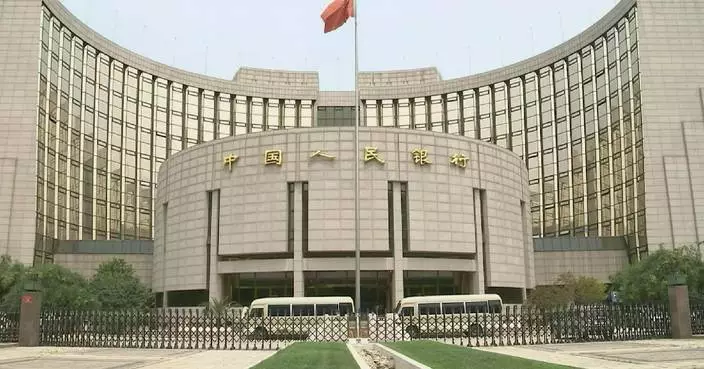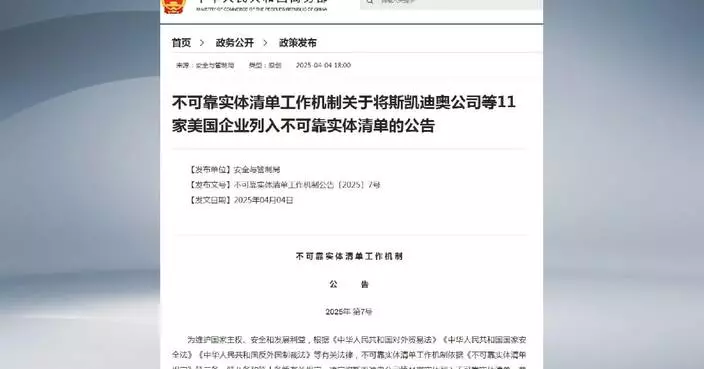NEW YORK (AP) — The WNBA looks promising heading into the offseason after a banner year with record ratings, attendance and a first-time champion in New York.
Soon after the confetti stopped falling on the sellout crowd at Barclays Center following Game 5 of the WNBA Finals, the league and its players turned their attention to 2025.
Less than 24 hours after Sunday night's game and days before the Liberty's championship parade on Thursday, the players' union opted out of the current collective bargaining agreement. The decision was expected with a new 11-year media rights deal worth approximately $200 million per year beginning in 2026. The players are looking for a bigger share of the revenue pie among other things, including pensions and higher salaries.
The current CBA will still be in effect throughout next season, but both sides would like to get a deal done sooner rather than later.
Negotiations are always intense, but those associated with the WNBA have much to be excited about.
The league is expanding and will increase the number of regular season games to 44. The WNBA will hold an expansion draft for Golden State in December. The Valkyries will be the league's 13th franchise. The league will add franchises in Toronto and Portland in 2026, with at least one other team starting in either 2027 or 2028.
Although the WNBA could lose one of its iconic stars if Diana Taurasi announces her retirement, league officials are looking forward to another highly anticipated draft. The draft lottery is next month. It will determine who gets the first pick and potentially Paige Bueckers, who 21 years after Taurasi could become the next UConn guard to be selected No. 1.
Many of the league's top players will remain in the U.S. this winter and play in January in Unrivaled — the 3-on-3 league started by WNBA Finals standouts Breanna Stewart and Napheesa Collier.
The Stewart and Collier championship showdown led to strong ratings, with all five games having more than a million TV viewers. The decisive Game 5 drew an average of 2.2 million viewers, peaking at 3.3 million, which made it the most-watched WNBA game in 25 years.
The league as a whole had its most-watched regular season in 24 years and best attendance in 22 seasons. During the 40-game regular season, 22 telecasts topped at least a million viewers on a host of networks.
The league's rookie class, led by Caitlin Clark and Angel Reese, was a big part of that success — and all should come back stronger and better next year.
“When Caitlin Clark announced she was going to enter the draft, I remember ... the wave of enthusiasm that came from a player that wasn’t even going to play for the Lynx,” Minnesota coach Cheryl Reeve said. “So there was a lot of excitement and momentum for the WNBA. But to see it actually translate business-wise across the league, whatever the reasons were. There’s one really big reason and a lot of other little reasons why. And I think the movement that we’re in now is exciting.”
Not everything has been positive around the league's growth.
Nearly half of the WNBA franchises have fired coaches in the past month. Atlanta, Chicago, Dallas, Los Angeles and Washington are all looking for new leaders on the sidelines. All of the coaches who were let go had three years or less with their teams.
Off the court, players say they were targets of increasing online racial and homophobic threats, including one to Stewart and her wife during the WNBA Finals.
Commissioner Cathy Engelbert addressed the rising number of abusive comments players have dealt with on social media at her state of the league address before the start of the WNBA Finals. She said the league will work with the players’ union to figure out what they can do together to combat it.
The online abuse and the CBA are two of the offseason issues the WNBA and its players must address, but they have arguably the strongest foundation since the league's launch to build on.
AP WNBA: https://apnews.com/hub/wnba-basketball

New York Liberty guard Sabrina Ionescu (20) reacts after scoring against the Minnesota Lynx during the third quarter of Game 5 of the WNBA basketball final series, Sunday, Oct. 20, 2024, in New York. (AP Photo/Pamela Smith)

FILE - WNBA Commissioner Cathy Engelbert speaks at a news conference before Game 1 of basketball's WNBA Finals between the Connecticut Sun and the Washington Mystics, Sunday, Sept. 29, 2019, in Washington. The WNBA will expand its Finals next year to a best-of-7 format the league announced on Thursday, Oct. 10, 2024. (AP Photo/Patrick Semansky, File)

FILE - The WNBA logo and hoop are seen at a WNBA basketball game at Mohegan Sun Arena, Tuesday, May 14, 2019, in Uncasville, Conn. (AP Photo/Jessica Hill, File)
NEW YORK (AP) — U.S. stocks are rallying Tuesday after companies reported fatter profits than expected, and other U.S. investments are also steadying a day after falling sharply on worries about President Donald Trump’s trade war and his attacks on the head of the Federal Reserve.
The S&P 500 was 2% higher in morning trading and on track to recover most of Monday’s drop. The Dow Jones Industrial Average was up 765 points, or 2%, as of 10:45 a.m. Eastern time, and the Nasdaq composite was 2.2% higher.
The value of the U.S. dollar also stabilized after sliding against the euro and other competitors, while Treasury yields held steadier. Sharp, unusual moves in those markets have recently raised worries that Trump’s policies are making investors more skeptical that U.S. investments still deserve their reputations as the world’s safest.
The only prediction many Wall Street strategists are willing to make is that financial markets will continue to jerk up and down as hopes rise and fall that Trump may negotiate deals with other countries to lower his tariffs. Otherwise, many investors expect the economy to fall into a recession.
The International Monetary Fund on Tuesday slashed its forecast for global economic growth this year to 2.8%, down from 3.3%. But Vice President JD Vance also said he made progress with India's prime minister, Narendra Modi, on trade talks Monday.
Some signs of nervousness remain in financial markets. Gold continued to rise, for example, as it holds onto its reputation as a safer investment when fear is dominating markets.
A suite of better-than-expected profit reports from big U.S. companies, meanwhile, drove U.S. stocks higher.
Equifax jumped 11.8% after reporting better profit for the first three months of 2025 than analysts expected. It also said it would send more cash to its shareholders by increasing its dividend and buying up to $3 billion of its stock over the next four years.
3M climbed 7.6% after the maker of Scotch tape and Command strips said it made more in profit from each $1 of revenue during the start of the year than it expected. The company also stood by its forecast for profit for the full year, though it said tariffs may drag down its earnings per share by up to 40 cents per share.
Homebuilder PulteGroup rose 6.2% after it likewise delivered a stronger profit for the start of 2025 than analysts expected.
It’s been benefiting from the sharp moves in the bond market. The unusual drops for Treasury yields recently are translating into lower rates for mortgages for potential customers. The drops for stock prices that are happening at the same time, though, are likely also scaring potential buyers.
CEO Ryan Marshall said buyers “remain caught between a strong desire for homeownership and the affordability challenges of high selling prices and monthly payments that are stretched.”
Tesla rose 4.1% ahead of its earnings report, which is scheduled to arrive after trading ends for the day. That trimmed its loss for the year so far below 42%.
Elon Musk’s electric car company has already reported its first-quarter car sales dropped by 13% from the year before. It's been hurt by vandalism, widespread protests and calls for a consumer boycott amid a backlash to Musk’s high-profile role in the White House overseeing a cost-cutting purge of U.S. government agencies.
Stocks also showed how Trump’s tariffs could create winners and losers in a remade global economy.
First Solar jumped 13.5% after the U.S. Department of Commerce finalized harsher-than-expected solar tariffs on some southeast Asian communities.
Defense contractors had some of the market's sharpest losses after RTX said U.S. tariffs on Mexican and Canadian imports, along with other products, could mean an $850 million hit to its profit this year. RTX, which builds airplane engines and military equipment, fell 8.4% even though it reported a stronger profit for the latest quarter.
Kimberly-Clark lost 2.2% even though the maker of Huggies and Kleenex likewise reported a better-than-expected profit.
CEO Mike Hsu said that “the current environment will now mean greater costs across our global supply chain” versus what it expected at the start of the year, and the company lowered its forecast for an underlying measure of profit this year.
In the bond market, the yield on the 10-year Treasury eased to 4.39% from 4.42% late Monday.
AP Business Writers Yuri Kageyama and Matt Ott contributed.
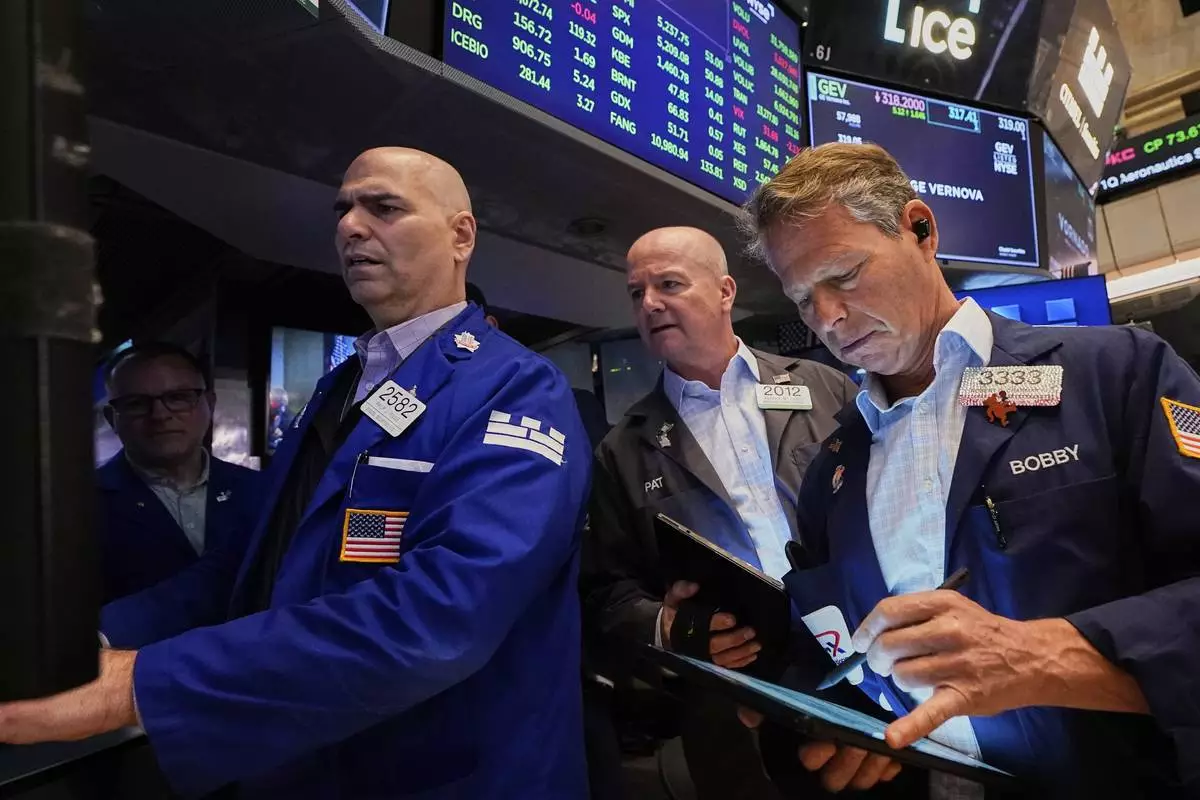
Specialist Philip Finale, left, works with traders Patrick Casey, center, and Robert Charmak on the floor of the New York Stock Exchange, Tuesday, April 22, 2025. (AP Photo/Richard Drew)
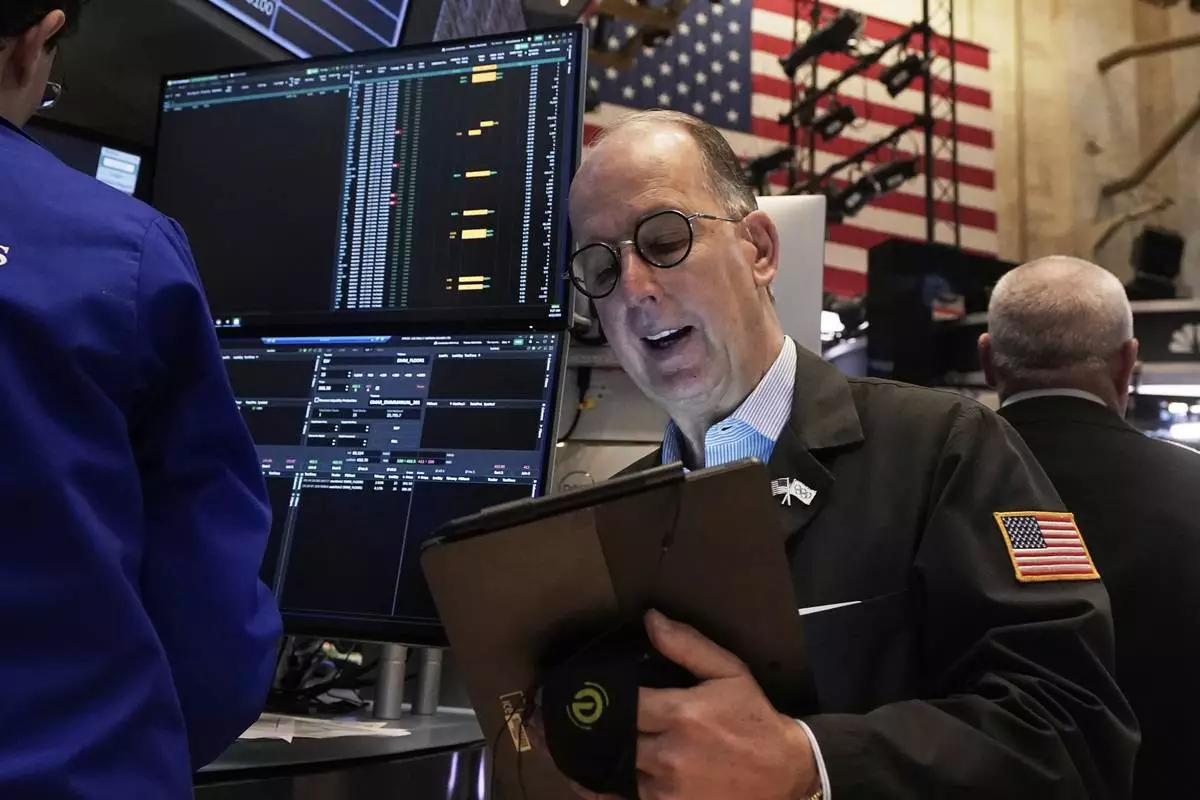
Trader Joe Dente works on the floor of the New York Stock Exchange, Tuesday, April 22, 2025. (AP Photo/Richard Drew)
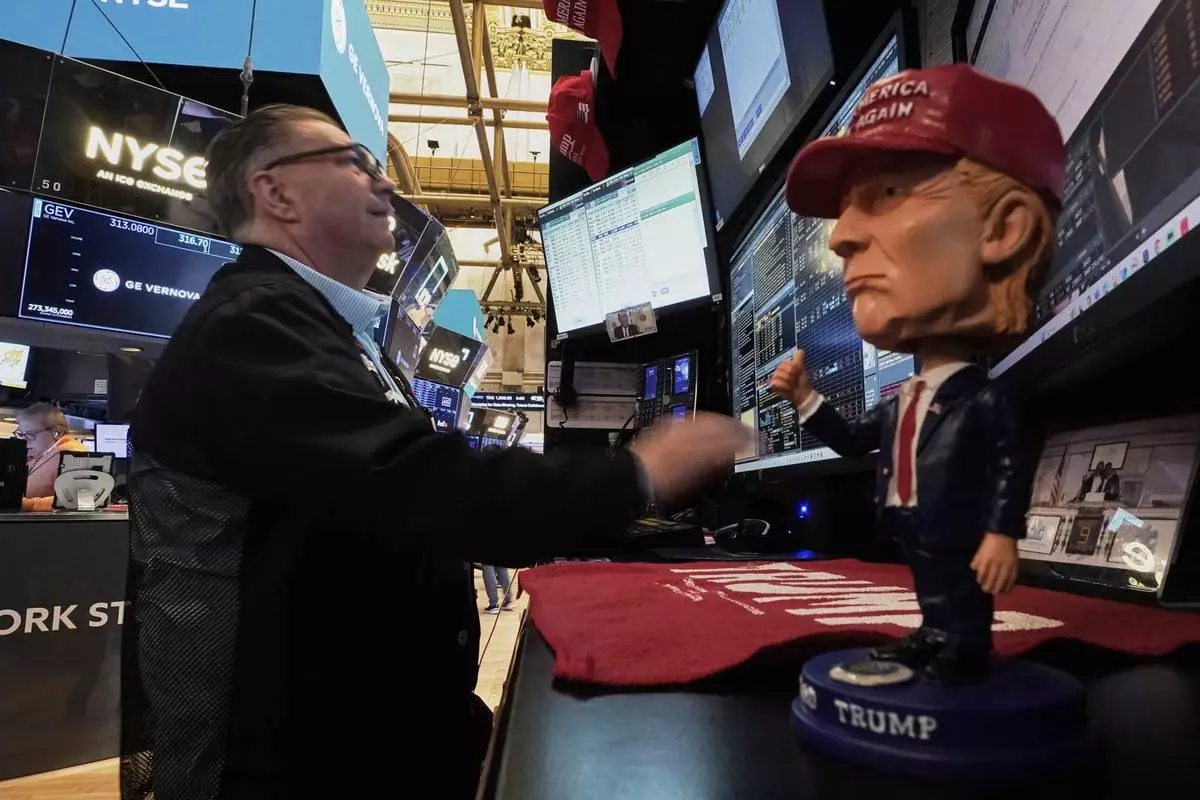
A Donald Trump bobblehead sits on the counter as trader Jonathan Mueller works on the floor of the New York Stock Exchange, Tuesday, April 22, 2025. (AP Photo/Richard Drew)

Specialist James Denaro, right, and trader Dylan Halvorsan, center, work on the floor of the New York Stock Exchange, Tuesday, April 22, 2025. (AP Photo/Richard Drew)
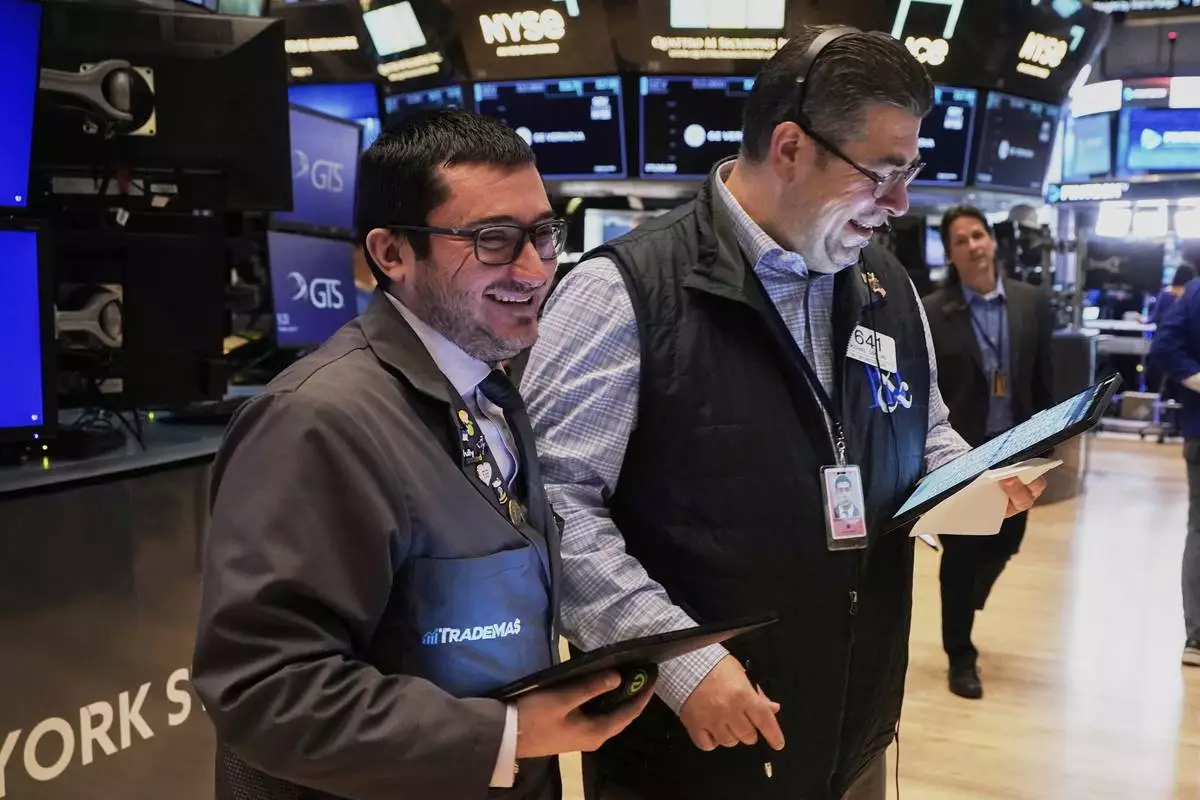
Traders Drew Cohen, left and Michael Capolino work on the floor of the New York Stock Exchange, Tuesday, April 22, 2025. (AP Photo/Richard Drew)

Currency traders watch monitors near a screen showing the Korea Composite Stock Price Index (KOSPI), top left, and the foreign exchange rate between U.S. dollar and South Korean won, top center, at the foreign exchange dealing room of the KEB Hana Bank headquarters in Seoul, South Korea, Tuesday, April 22, 2025. (AP Photo/Ahn Young-joon)

Currency traders work near a screen showing the Korea Composite Stock Price Index (KOSPI) and the foreign exchange rate between U.S. dollar and South Korean won, top right, at the foreign exchange dealing room of the KEB Hana Bank headquarters in Seoul, South Korea, Tuesday, April 22, 2025. (AP Photo/Ahn Young-joon)

A currency trader watches monitors near a screen showing the Korea Composite Stock Price Index (KOSPI) at the foreign exchange dealing room of the KEB Hana Bank headquarters in Seoul, South Korea, Tuesday, April 22, 2025. (AP Photo/Ahn Young-joon)




























